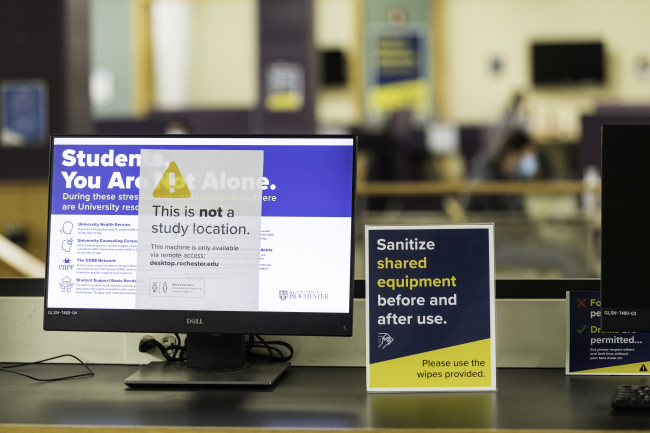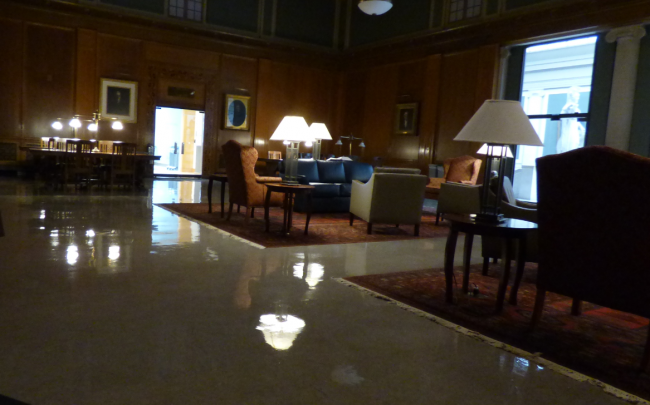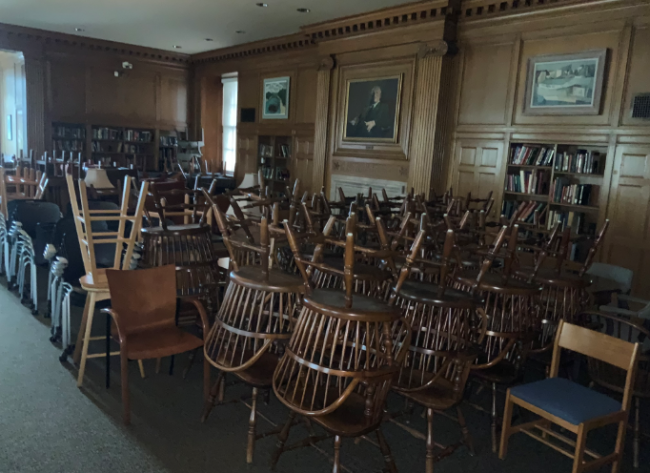
What day is it?
Time is a flat circle.
Time has no meaning.
These have been common refrains for just about everyone throughout the COVID-19 pandemic. Yet, earlier this month, our time bubbles were burst by…time. It has, impossibly and in fact, been a year.
On March 9, the University of Rochester recognized the anniversary with a moment of silence. It marked the day Medical Center leaders gathered in preparation of COVID-19 coming to the Greater Rochester area. On March 12, the first COVID patient was admitted to Strong Memorial Hospital. Six days after that, the River Campus Libraries closed all of its physical spaces.
Since April 2020, the University Archives has been collecting photographs, journal entries, and other materials that offer personal reflections on the ways students, staff, faculty, alumni, parents, and friends of the University have been affected by the pandemic. For example, a Medical Center staff member shared her journal entries.
In reflection of the longest year of our lives, we talked to librarians and staff from the River Campus Libraries (RCL), Edward G. Miner Library at the Medical Center, and the Sibley Music Library at the Eastman School of Music for their memories and current state of mind, as COVID continues to be part of our lives.
Part I. A slow sense of dread
COVID-19 wasn’t always the ubiquitous threat it is today. Staff discovered the novel coronavirus in different ways and with different outlooks.
Laquanda M. Fields (student projects and student employment manager, RCL): A few weeks before I had left my previous job, there were conversations about this potentially scary illness. But [the conversations] were very like, there's no way that it would come here.
Rick McRae (catalog librarian, Sibley Library): It came over the news that there was a treatable virus that was coming from Wuhan, China, and it was creating a lot of casualties and doctors couldn’t figure it out. Like any disaster, you kind of say, “My god; that looks pretty bad.” I kind of viewed it as this thing that was happening on the other side of the world. So, I wasn’t really concerned at the time.
Autumn Haag (assistant director, Department of Rare Books, Special Collections, and Preservation, RCL): This sounds really shallow, but it sounded like somebody else's problem. It sounded like something happening on the other side of the world that you might hear about for a week or two in the news, and then it would kind of just disappear. After a couple of weeks, it was clear that wasn't happening. It was this slow sense of dread.
Anna Siebach-Larsen (director, Rossell Hope Robbins Library, RCL): When they started finding cases outside [China] it became clear to me that it was going to be pretty significant. At the very least, we would need to be adopting some changes in behavior, like universal masking. Once it hit Italy, I felt like it was just a matter a matter of time until we had to close everything down.
Claudia Pietrzak (student experience and social media manager, RCL): The first week of March, I served my first jury duty. And I remember seeing another potential juror in a full gas mask. I was like, this guy's just trying to get out of jury duty. But he was probably smarter than the rest of us to actually be doing that.
Todd Smith (section supervisor, Collection Strategies, RCL): You know it didn’t seem like it was that serious. It seemed like it would be like the bird flu or one of the minor flu outbreaks that concern people, but never turn out to be anything. Even when it came to the U.S., it didn’t seem like it was going to be that big of a deal.
Jeffery Jones (section supervisor, Physics-Optics-Astronomy Library, RCL): I don’t think we had any idea how life-changing this would be.
Part II. Trying to adapt
In mid-March, physical library spaces closed to patrons. Staff primarily worked from home; however, some were partially or fully furloughed over the summer.
Katie Papas (section supervisor, Robbins Library, RCL): I remember leaving campus and being terrified. I didn't know what this was. We're shutting down. What does that even mean?
Tom Clifford (section supervisor, Art & Music Library, RCL): Part of it was this feeling of “Well, I’m living through history right now.” A college doesn’t shut down unless it’s a big deal.
Melinda Wallington (section supervisor, Department of Rare Books, Special Collections, and Preservation, RCL): It was a very emotional thing to hear that I was being furloughed 50 percent. Because all those thoughts go through your mind—Am I expendable? Is this what they think of me? It was really difficult not to take that personally and understand that is what [the University] has to do to retain us all. I have two children, our daycare shut down, and my husband was laid off. And it's just like, all this was happening at once. How do you manage that without losing your mind? Autumn [Haag] did a wonderful job reassuring me without any false optimism. I was really touched by that.
Marc Bollmann (senior library assistant, Art & Music Library, RCL): Initially when we were furloughed, the reserves team got together and called ourselves the “Furlough Bros.” We formed a Discord, so we were able to communicate, not necessarily just about work; we were able to navigate the unemployment websites. It was more like group therapy.
Jennifer Raynor (director, Miner Library): We sent everyone home, but all Medical Center staff, regardless of what you do, you’re classified as essential. What that means is, we could be called upon to staff the front doors or move supplies. So we were kind of all in this on-call, ready to be redeployed situation. In fact, several of the librarians trained to be standardized patients, which are essentially actors who portray patients for medical students.
Frank Scarcelli (mail and physical spaces assistant, RCL): For the first week, I had this feeling in my stomach—like a kind of loneliness.
Autumn Haag (assistant director, Department of Rare Books, Special Collections, and Preservation, RCL): Fairly early on, I was going in just to check the temperature and humidity in the department and make sure the books were fine. It was really eerie. I'm used to the library as this place of life and conversation and faces, and it was the exact opposite.

Frank Scarcelli (mail and physical spaces assistant, RCL): Staff would call me and say, “Frank, would you do me a favor? I have something on my desk that I need desperately. If I tell you where it is, will you get it?” Then they would make an appointment with me to pick it up from the [loading] dock.
Anna Siebach-Larsen (director, Rossell Hope Robbins Library, RCL): We had no idea when we would be able to get back in. The focus was—What can people do from home? How can we get people materials? What is available online that we can get to [patrons]? And then, also, how can we be checking in regularly to make sure that everybody—both full time staff and students—is supported?
Jennifer Raynor (director, Miner Library): It was a really stressful time. There was so much uncertainty. Our biggest concerns were around rebuilding our communication infrastructure. We were meeting a lot more than we normally would.
Jeffery Jones (section supervisor, Physics-Optics-Astronomy Library, RCL): I'm really glad that we stopped when we did. That was helpful. It was very confusing because things were changing so rapidly, and we were trying to adapt.
Sarah Sexstone (section supervisor, Acquisitions, RCL): It was surreal that we were going to be shifting all of our work to a remote environment, especially for the work that I and the colleagues in my department do—we work with physical materials.
Laquanda M. Fields (student projects and student employment manager, RCL): Being very new to the University, I had no idea what I needed or how I was going to perform my job duties.
Jennifer Raynor (director, Miner Library): What we kept going, even when we were closed, was our interlibrary loan. Staff were going in a couple times a week to fill requests, as we are part of a network of hospital libraries. It was becoming increasingly difficult for their requests to be filled, and of course, all the academic libraries shut down. So it was really important to keep that [service] open so we could continue to supply articles that were being used to directly support patient care or potentially COVID research.
Part III. Ready to reopen
Phase Two of New York State’s reopening plan allowed the University’s library spaces to reopen. On June 29, the Barbara J. Burger iZone reopened as a study space for students. Sibley Library also reopened. For some, it was the first time being back in their physical workplace since March.
Emily Clasper (director, Service Strategies, RCL): I started to go back when we started to get iZone ready to reopen. It was terrifying, because we didn't know what to expect. I didn't know if there'd be like a lot of people, but it turned out to be like a ghost town. And it was super weird. Everybody had left things. There was the whiteboard that had a St. Patrick's Day drawing on it. People had left cans of soda on their desk. There were all sorts of things like that. It was like going into Pompeii.
Randall Cook (assistant dean, RCL): It was a summer of uncertainty, of shifting rules. We were all trying to plan for reopening the [River Campus], but not at all on sure footing. Once we knew we were going to have a de-densified space, we had to remove about 70 percent of our seats.

Rick McRae (catalog librarian, Sibley Library): We took large tables and roped off lots of seating. For example, a table for eight would not sit more than two people. And we put in signage about no more than one person in a restroom, no more than one person in an elevator, and masks were required. We had [sanitizer] bottles everywhere. We wiped down surfaces and keyboards when we were done with them. We instituted all these protocols before the doors actually opened.
Sue Atkins (answer desk manager, Miner Library): The prep was a lot of work—to distance everything and set up all the sanitizing stations. But I think we were really well prepared for when we did let the students back in.
Randall Cook (assistant dean, RCL): All the work of preparing to open felt really good. It felt good to be taking steps toward normalization.
Katie Papas: When I heard iZone was reopening, I immediately reached out to Emily [Clasper] and said, “I’m in.” My comfort level at that point was pretty high, in terms of leaving my house, and I knew I had colleagues that weren’t as comfortable with that. I was overwhelmingly happy to be back. It was like, I know this is weird, but I don’t care.
Emily Clasper (director, Service Strategies, RCL): It was all very weird, but I got used to it. It felt like starting a new job.
Rick McRae (catalog librarian, Sibley Library): The library decided to reopen, physically, in early July, but only on a three-day-a-week basis. So, every other week until my furlough was lifted in late August, I would go in on those days for circulation duties. And I loved it. And the patrons, students, or faculty members that came in expressed how happy they were to come into the library.
Todd Smith (section supervisor, Collection Strategies, RCL): One of the most difficult things was not being attached to the community. There was nobody here. [My team] is very much the front line. We get people what they need, or take them where they need to go. Without the people when we first came back… that disconnect was really kind of difficult.
Anna Siebach-Larsen (director, Rossell Hope Robbins Library, RCL): The first time I walked back in, I almost started to cry. It was so nice to be back with the collections, and thinking about the community that we have in Robbins and just realizing how much I missed that was pretty overwhelming. ∎
Interested in contributing to the University Archives COVID-19 project? Fill out this brief submission form. If you have questions, contact Melissa Mead at archives@library.rochester.edu. Enjoy reading about the University of Rochester Libraries? Subscribe to Tower Talk.

